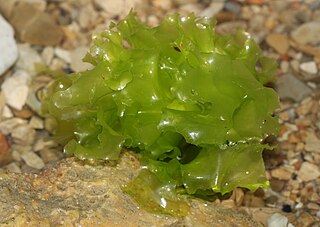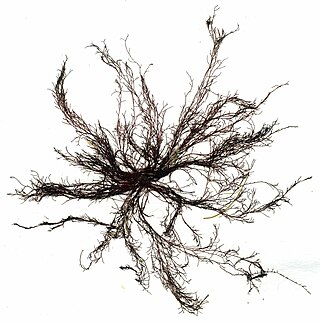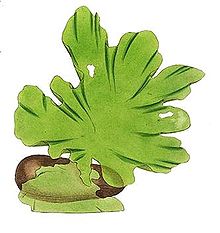
Chondrus crispus—commonly called Irish moss or carrageenan moss —is a species of red algae which grows abundantly along the rocky parts of the Atlantic coasts of Europe and North America. In its fresh condition it is soft and cartilaginous, varying in color from a greenish-yellow, through red, to a dark purple or purplish-brown. The principal constituent is a mucilaginous body, made of the polysaccharide carrageenan, which constitutes 55% of its dry weight. The organism also consists of nearly 10% dry weight protein and about 15% dry weight mineral matter, and is rich in iodine and sulfur. When softened in water it has a sea-like odour. Because of the abundant cell wall polysaccharides, it will form a jelly when boiled, containing from 20 to 100 times its weight of water.

Alternation of generations is the predominant type of life cycle in plants and algae. In plants both phases are multicellular: the haploid sexual phase – the gametophyte – alternates with a diploid asexual phase – the sporophyte.

Fucus vesiculosus, known by the common names bladderwrack, black tang, rockweed, sea grapes, bladder fucus, sea oak, cut weed, dyers fucus, red fucus and rock wrack, is a seaweed found on the coasts of the North Sea, the western Baltic Sea and the Atlantic and Pacific Oceans. It was the original source of iodine, discovered in 1811, and was used extensively to treat goitre, a swelling of the thyroid gland related to iodine deficiency.

The sea lettuces comprise the genus Ulva, a group of edible green algae that is widely distributed along the coasts of the world's oceans. The type species within the genus Ulva is Ulva lactuca, lactuca being Latin for "lettuce". The genus also includes the species previously classified under the genus Enteromorpha, the former members of which are known under the common name green nori.

Fucus is a genus of brown algae found in the intertidal zones of rocky seashores almost throughout the world.

Palmaria palmata, also called dulse, dillisk or dilsk, red dulse, sea lettuce flakes, or creathnach, is a red alga (Rhodophyta) previously referred to as Rhodymenia palmata. It grows on the northern coasts of the Atlantic and Pacific Oceans. It is a well-known snack food. In Iceland, where it is known as söl, it has been an important source of dietary fiber throughout the centuries.

Alaria esculenta is an edible seaweed, also known as dabberlocks or badderlocks, or winged kelp, and occasionally as Atlantic Wakame. It is a traditional food along the coasts of the far north Atlantic Ocean. It may be eaten fresh or cooked in Greenland, Iceland, Scotland and Ireland. It is the only one of twelve species of Alaria to occur in both Ireland and in Great Britain.

Fucus serratus is a seaweed of the north Atlantic Ocean, known as toothed wrack, serrated wrack, or saw rack.

Polysiphonia, known as red hair algae, is a genus of filamentous red algae with about 19 species on the coasts of the British Isles and about 200 species worldwide, including Crete in Greece, Antarctica and Greenland. Its members are known by a number of common names. It is in the order Ceramiales and family Rhodomelaceae.

The genus Umbraulva, which is a green alga within the Ulvaceae family, was proposed by Bae and Lee in 2001. Three additional species, including U. kuaweuweu, which was subsequently transferred to another genus, have been added to the genus since it originally had the three species that were initially examined to form the genus. Umbraulva species grow upon hard substrates, and inhabit deep subtidal areas. Species within this genus are widely distributed, and have been identified in Asia, Europe, Hawaii, and New Zealand. The morphological traits of Umbraulva vary among species, but commonly, Umbraulva are macroscopic with olive green blades containing the photosynthetic pigment siphonaxanthin. The blades are flattened and ellipsoid in shape, or are narrow and oval shaped, with perforations and/or lobes present throughout the blade. As Umbraulva often appear very similar in morphology to closely related groups, the main manner in which Umbraulva was differentiated from related groups was through the divergence of ITS and partial SSU rDNA sequences from those of other Ulva species. Umbraulva is closely related to Ulva, which due to wide distributions, high carbohydrate levels, and a lack of lignin, is a good candidate for use in biofuel, bioremediation, carbon sequestration, and animal feed production.

Saint-Michel-en-Grève is a commune in the Côtes-d'Armor department of Brittany in northwestern France.

Seaweed, or macroalgae, refers to thousands of species of macroscopic, multicellular, marine algae. The term includes some types of Rhodophyta (red), Phaeophyta (brown) and Chlorophyta (green) macroalgae. Seaweed species such as kelps provide essential nursery habitat for fisheries and other marine species and thus protect food sources; other species, such as planktonic algae, play a vital role in capturing carbon and producing at least 50% of Earth's oxygen.

Ulva intestinalis is a green alga in the family Ulvaceae, known by the common names sea lettuce, green bait weed, gutweed, and grass kelp. Until they were reclassified by genetic work completed in the early 2000s, the tubular members of the sea lettuce genus Ulva were placed in the genus Enteromorpha.

Fucus distichus or rockweed is a species of brown alga in the family Fucaceae to be found in the intertidal zones of rocky seashores in the Northern Hemisphere, mostly in rock pools.

Ulva linza is a green alga in the family Ulvaceae that can be found in British Isles.

Jania is a genus of red macroalgae with hard, calcareous, branching skeletons in the family Corallinaceae.

Ulva prolifera, also known as the branched string lettuce, is a species of seaweed algae in the family Ulvaceae that can be found worldwide.

Ulva paschima is a green alga in the family Ulvaceae, a green seaweed endemic to the West Coast of India. The species was identified in 2014 based on molecular phylogenetics using ITS sequences as belonging to the “Paschima” clade.


















